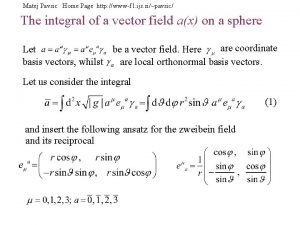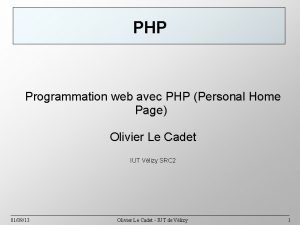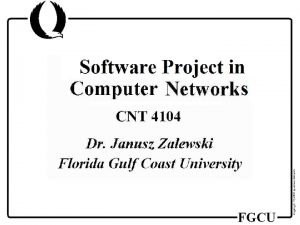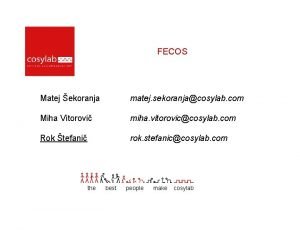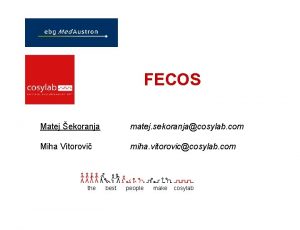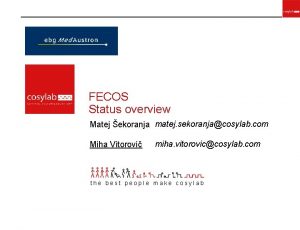Matej Pavsic Home Page http wwwf 1 ijs








- Slides: 8

Matej Pavsic Home Page http: //www-f 1. ijs. si/~pavsic/ The integral of a vector field a(x) on a sphere are coordinate Let be a vector field. Here basis vectors, whilst are local orthonormal basis vectors. Let us consider the integral (1) and insert the following ansatz for the zweibein field and its reciprocal

The orthonormal frame vectors are Explicitly we have Orthonormal vectors are rotated at different points on the sphere in such a way that the orthonormal frame at point x is parallel to the orthonormal frame at a fixed chosen point x’ (parallel along the geodesic joining the two points). If we let the point x vary, then the orthonormal frames at different points x are not parallel to each other, they are only all parallel to the frame at a chosen fixed point x’. We can represent vectors on the sphere. by matrices which are constant

The integral now reads If we take constant components a 1, a 2 in the coordinate frame, the result of the integrations is zero. This result makes sense, because at various points x the components aa have different orientations with respect to the orthonormal frame. When we parallel transport the frame and the vector field a from x into a chosen point x’, then at the latter point we have vectors of all possible orientations, and all those vectors are then summed together. So we obtain zero for the domain of point x covering the entire sphere. For the integration over a smaller domain we may obtain a non vanishing result. However, the integral is defined with respect to a chosen zweibein. If we take a different zweibein the result will change. Our choice of the zweibein is such that, in the limit of the transition to a flat space, it coincides with the choice of zweibein in the definition of the vector integral in flat space.

The integral of a vector field a(x) in flat 2 -space We will now demonstrate that even in flat space the vector integral depends on choice of vielbein (zweibein in our 2 -dimensional example). Let us consider (1) Choosing the cartesian coordinates we have d 2 x = dx dy I. Let us first take Then the local frame that coincides with the coordinate frame. The integral (1) reads which means This is just the usual expression for the vector integral in flat space.

II. Alternativly, we can take The frame field depends on position x, y. In every point x, y the local vectors are rotated for a different angle. with respect to the coordinate frame vectors (which are tangent to the coordinate lines). We take cartesian coordinates. The integral of a vector field over a domain in 2 -space reads Let us take for example

Then we obtain 1) Let us choose and let us write 2) Let us choose The integral depends on choice of possible in principle. Any choice is

There is a choice which is very convenient and is normally used: We take such that the local orthonormal frame vectors at variable points (x, y) are parallel to the local frame vectors in a given fixed point (x’, y’). Local frame vectors need not coincide with coordinate frame vectors; they only need to be parallel in the above sense. In flat space it happens that such a parallelism coincides with the global parallelism (the local frames at all points can be chosen such that they are all parallel to each other).

When going from flat to curved space the global parallelism is not preserved. We have seen that the latter property is not needed. What we need is that at all points within a chosen domain on a manifold the local orthonormal frames are parallel to a local orthonormal frame at a chosen fixed point x’. Such condition, used in the definition of the flat space vector integral can be preserved in curved space, and can be used for the definition of the vector integral in curved space. If we then make a gradual transition so that a curved space approaches flat space (curvature decreases, e. g. , the radius of our sphere is becoming larger and larger) then the integral of a vector field over a finite area domain around a chosen fixed point x’ approaches the usual definition of the flat space vector integral.
